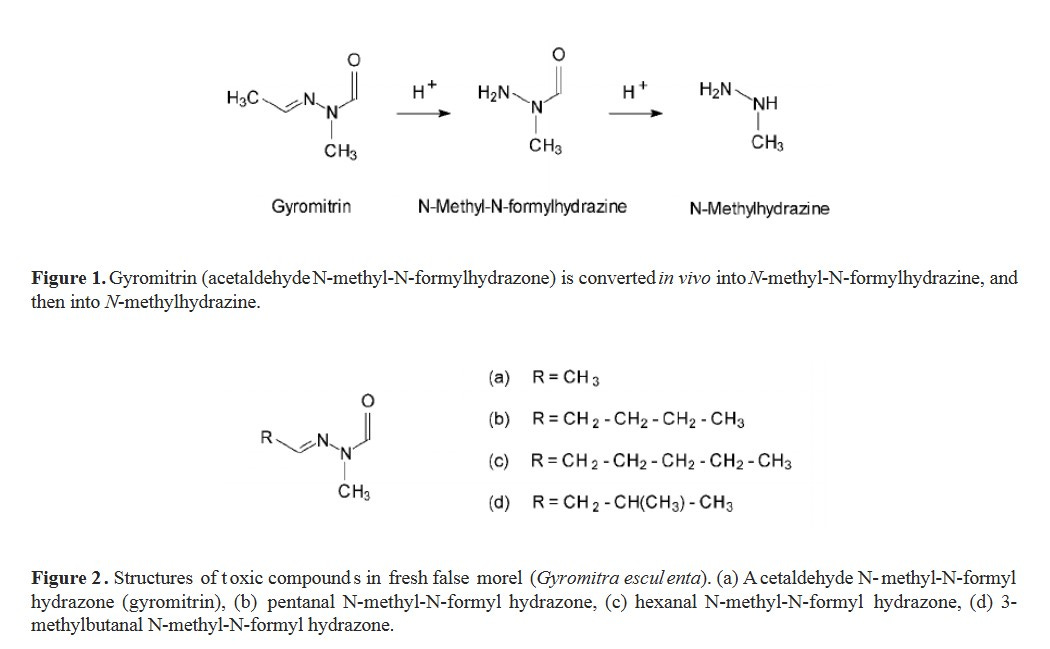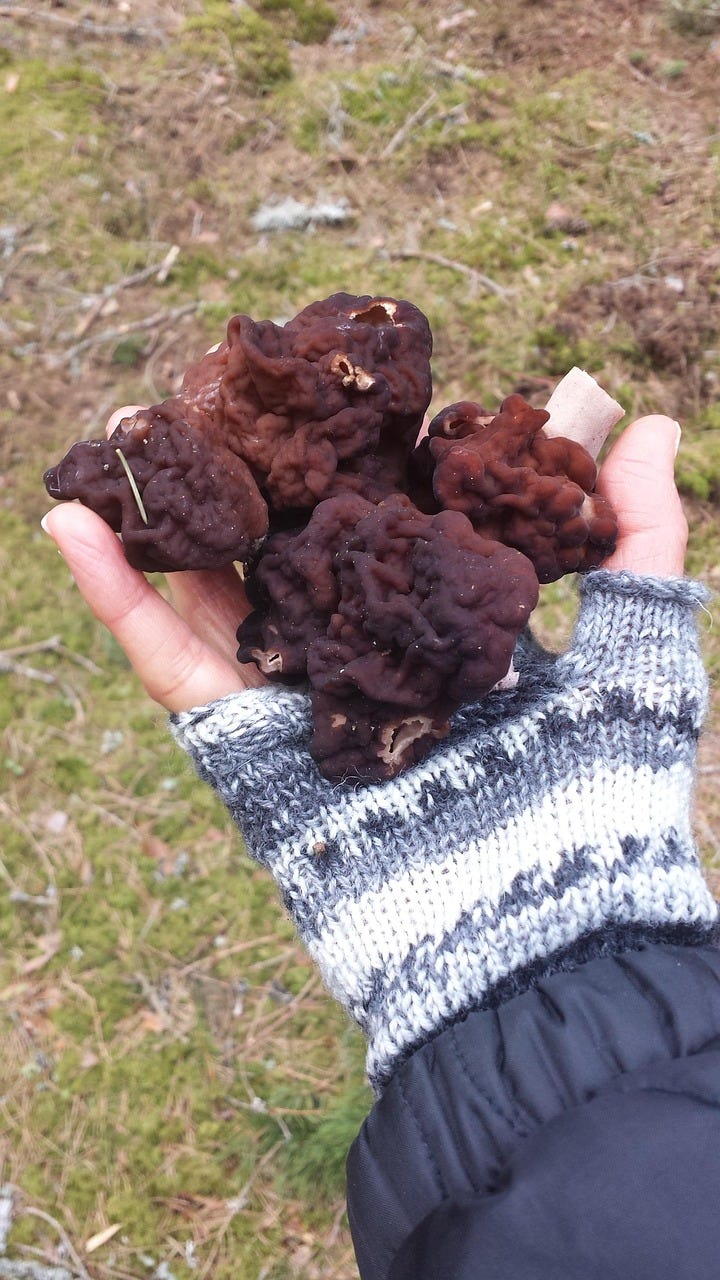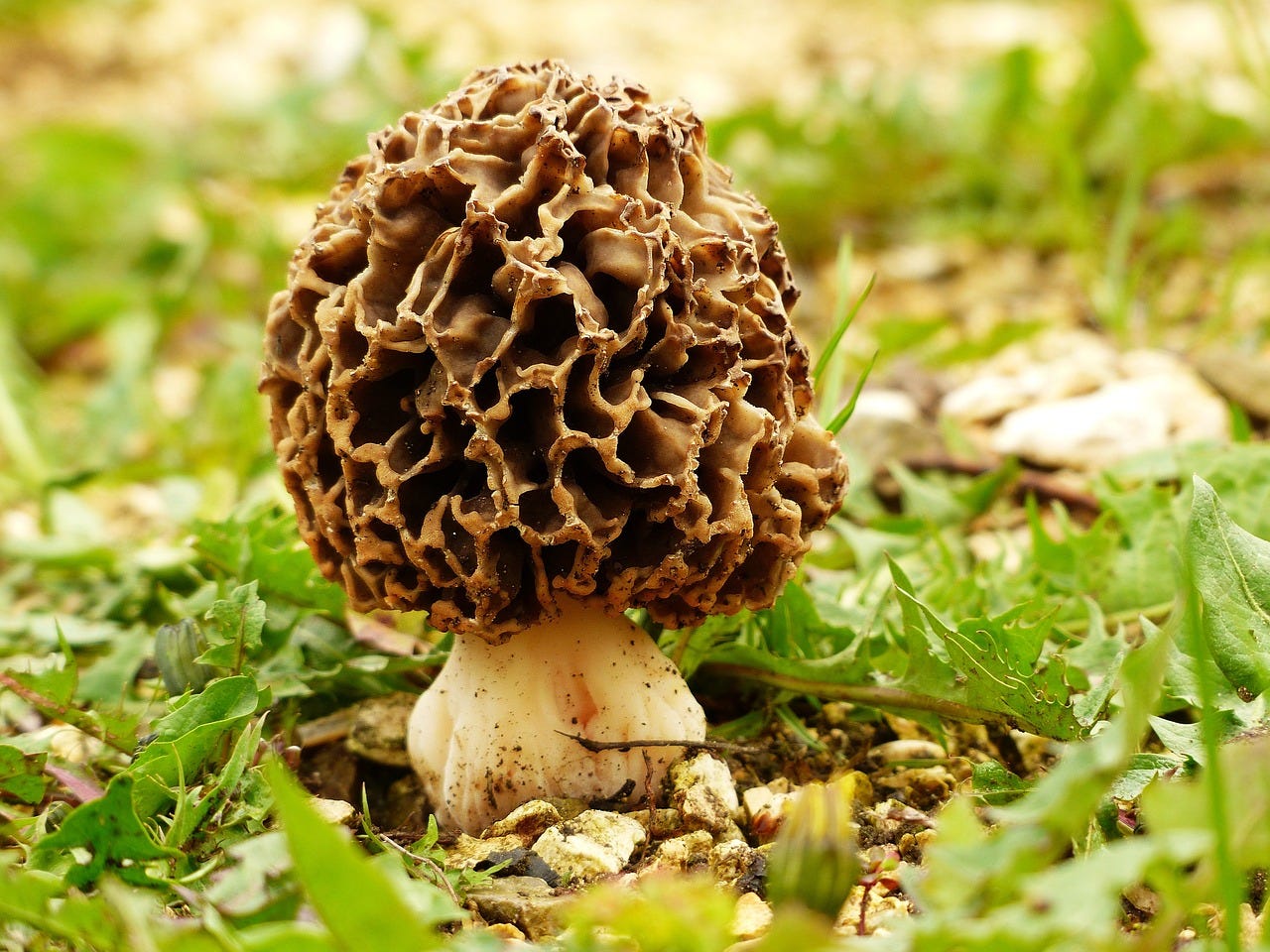For wild mushroom enthusiasts, the most exciting season of the year starts in March and runs through May, depending on the foraging range in the northern hemisphere. In high elevations the season may extend through June. The much sought after morels (Morchella) tend to pop up around the same time as the first appearance of the Mayapple weeds. These popular delicacies are fairly easy to recognize by their distinctive pitted, roughly conical caps. There's a taxonomical wall (Discinaceae) dividing off the false morels, which have been associated with marked toxicity, and with some potentially fatal neurological consequences.
In time for this year's season articles in the popular press have recounted a cluster of ALS (amyotrophic lateral sclerosis) cases in the tiny, French Alpine village of Montchavin. 16 patients had been afflicted with this terrible neurological disease, vastly outstripping the normal frequency of appearance. After an extensive survey of of people in the general area (total population 900), a common thread appeared among those afflicted. They liked to forage and eat false morels. While this doesn't provide incontrovertable evidence that those mushrooms caused their affliction, it's enough to dissuade many from even messing with them. And it calls for a foray into the chemistry, in honor of the nervy people who still attempt to detoxify, and eat these shrooms.
Complicating the situation is the ever changing taxonomy of the false morels, which some mycologists wish to designate as lorchels, since they are no kind of morel. Take for example the Gyromitra gigas, European snow mushroom, that was first implicated in the ALS outbreak in Montchavin. That species, as well as its U.S. counterpart, is now known by 3 different genus names: Gyromitra, Discina and most recently, Maublancomyces. 5 syllables are better than 3 or 4, and coolest of all, it’s now named after a person rather than its morphology, so the nomenclature can no longer evoke a visual concept of the organism, even for people who studied the ancient languages.
It’s fairly instructive for budding mushroom hunters, that species mixups regularly occur when identifying the fungi, including the toxic little one that might have led to such neurological damage as ALS. Gyromitra esculenta is the more likely culprit, as it contains more than 1000 times as much of the proposed toxin, gyromitrin (up to 1500mg/kg fresh weight), as the “milder” M. gigas species. So this Gyromitra esculenta got to keep its old genus name, which is probably a good thing. Only a minority of the false morels have been specifically found to contain gyromitrin. These have been renamed into 2 genera: Piscidiscina (2 species) and Gyromitra (5 to 6 species), with the esculenta species being apparently the top offender. If you are deep into the false morels, and have already been eating some of the less toxic species, please check here and here for the latest on exactly which species contain more than 2 mg. per kilogram fresh weight of gyromitrin. Lower quantities were not detectable by investigators who have been analysing the mushrooms.
NERD NOTE: The false morels are technically not “mushrooms”. They are the fruiting bodies of fungi called Ascomycetes, but we are sticking with that common term for these fungi as well as the morels and truffles, which fall into the same class, pezizomycetes.
By the way, the species name “esculenta” means edible, because some people are never going to stop eating this crazy shroom. The holdouts, a notable one being Finnish forager chef, Sami Tallberg, are largely in Northern Europe. Chef Tallberg says that humans are a part of nature, but we don’t control it. He seems to enjoy cooking on the edge, like those people who prepare the famous, tetrodotoxin-containing blowfish. But even he has a specified procedure for detoxifying the poisonous little schroom. He boils them for 5 minutes, rinses them, boils in new water for another 5 minutes, rinses them, then sautés them thoroughly, then cooks them some more in a sauce. Other chefs will boil the mushrooms for 10 minutes, twice, with the rinsing after each boil, followed by sautéing. Astonishingly, this seems not to cook away the rest of the flavor along with the gyromitrin.
One last suggestion which comes from the chemists: Gyromitrin is a water soluble, amall molecule that is easily hydrolysed in acidic medium. Heat and alkaline medium also break down the compound. Its degradation products are more volatile, and directly toxic when inhaled. This means that cooking and boiling ought to be done in a well ventilated area, particularly by those who do it professionally. The boiling point of Gyromitrin is 143 degrees C and that of N-methylhydrazine is 87 degrees C. The former could be carried in water vapor, while the latter would be volatilized directly, thereby allowing each to be inhaled directly into the lungs. This allows the compounds to bypass the liver for their first round through the circulatory system.
In the stomach, Gyromitrin, (acetaldehyde-N-methyl-N-formylhydrazone) or its homologs are hydrolyzed to N-methyl-N-formyl hydrazine. This is further converted either in the acidic environment of the stomach, or by P450 enzymes in the liver, to N-methyl hydrazine, (a.k.a. monomethylhydrazine) a directly toxic component. These active metabolites, formed in the stomach and liver, are also said to be present in the mushrooms themselves.

N-methyl-N-formylhydrazine and N-methylhydrazine are directly toxic to cells in the liver, leading to such unpleasantries as carcinogenesis and necrosis. Kidneys are also affected, though downstream, as it were.
N-Methylhydrazine exerts its neurotoxicity partially by inhibiting the conversion of glycine to gamma amino butyric acid (GABA). This causes depletion of GABA, the inhibitory neurotransmitter, leading to seizures and possibly death. The metabolites of gyromytrin also have more toxic potential to the nerve cells themselves, as they are destructive of DNA. As expected, the direct toxicities of false morels are fairly well explained, while the possible connection to long term, neurodegenerative disease is less studied from a pharmacological standpoint. The ALS cluster in France is recognized as similar to cycad seed poisoning seen in Guam decades ago, which resulted in a cluster of people exhibiting symptoms of ALS and other neurodegenerative maladies. A related form of poisoning was involved. The group of 16 of ALS patients in Montchavin, which even includes a married couple of false morel eaters both coming down with ALS, is a cautionary reminder that toxicity is not always readily apparent. With the low background rate of this terrible disease, such an concurrence is not likely random.
The numerous, less polar homologs of gyromitrin, which exist in the false morels, might have the potential to accumulate in the bodies of those who consume the mushrooms frequently. This could lead to potential long term effects which are not well studied thus far.
At weedom, we don’t derive mystical meaning from self-engineering brushes with death. The beef farming that happens here has its own inherent risks. Road trips among drugged out drivers, Boeing flying buses, health care, and various stupid ideas have already added enough spice to life over the years, and now we want to relax :-D So we’re not adding known toxic shrooms to our diet. If you share this outlook, here’s a brief guide that can help you choose the relatively benign morels, and avoid pitfalls that come from picking a toxic species of false morel.


True morel has deeply pitted caps, each pit having a discrete wall. False morel has a folded cap, which can look much more brainlike.
True morel is completely hollow inside the upper stem and cap, with bumpy but continuous inner walls . False morel can have a partly or near fully filled interior, which tends to be divided into numerous hollow chambers.
True morel cap is attached in a symmetrical manner all the way around the stem or stipe. False morel folded top appears to hang over the top of the stem with no symmetrical attachment to the side of the stem.
Spores of the true morel are light colored, cream colored. False morel has dark colored dark brown to black spores.
The true morel has much more regular, and symmetrical overall appearance. The false morel is much less regular and lacks symmetry.
Cutting the mushroom in half lengthwise is the best way to know you have a true (edible) morel and not a false morel, because it clarifies most of the above characteristics.
There are vast visual resources online which can help mushroom lovers know a true morel from a false one. Despite incredible morel fever each spring, the toxicity reports of hydrazine poisoning from the false morels is fairly rare, and no deaths from acute poisoning have been reported in the U.S. for decades. The main thrust of this article is to help people decide whether they want to risk a possible neurodegenerative side effect that might be linked to chronic exposure to the false morels.
As always, exercise caution when foraging. It’s suggested that beginners apprentice themselves to a surviving forager, the older the better. :-D The “lorchel” curious are encouraged to check out the references for a deeper dive.
Where We Dig
1. Was a Mushroom Behind an ALS Outbreak in the Alps? - The Atlantic. archive.is. March 23, 2025. Accessed March 31, 2025. https://archive.is/bJMoo
2. Young D. The Mysterious ALS Cluster in the French Alps: Is It Linked to Toxic Mushrooms? Young Research & Publishing Inc. December 30, 2024. Accessed April 1, 2025. https://www.youngresearch.com/researchandanalysis/the-mysterious-als-cluster-in-the-french-alps-is-it-linked-to-toxic-mushrooms/
3. (PDF) Not all bad: Gyromitrin has a limited distribution in the false morels as determined by a new ultra high-performance liquid chromatography method. ResearchGate. Published online December 9, 2024. Accessed March 31, 2025. https://www.researchgate.net/publication/366489382_Not_all_bad_Gyromitrin_has_a_limited_distribution_in_the_false_morels_as_determined_by_a_new_ultra_high-performance_liquid_chromatography_method
4. (PDF) Gyromitrin, mushroom toxin of Gyromitra spp. Accessed April 1, 2025. https://www.researchgate.net/publication/284155953_Gyromitrin_mushroom_toxin_of_Gyromitra_spp
5. Bergo A. On Cooking False Morels / Gyromitra. Forager | Chef. June 17, 2017. Accessed March 31, 2025. https://foragerchef.com/on-cooking-false-morels-gyromitra/
6. Dirks AC, Mohamed ,Osama G., Schultz ,Pamela J., Miller ,Andrew N., Tripathi ,Ashootosh, and James TY. Not all bad: Gyromitrin has a limited distribution in the false morels as determined by a new ultra high-performance liquid chromatography method. Mycologia. 2023;115(1):1-15. doi:10.1080/00275514.2022.2146473
7. Morchella. Midwest American Mycological Information. June 25, 2019. Accessed March 31, 2025. https://midwestmycology.org/morchella-americana/
8. Lorchel taxonomy overhauled: Synopsis of our Discinaceae phylogenomics publication. Alden Dirks. Accessed March 31, 2025. http://www.aldendirks.com/2/post/2025/01/lorchel-taxonomy-overhauled-synopsis-of-our-discinaceae-phylogenomics-publication.html
9. Spencer PS. Hypothesis: Etiologic and Molecular Mechanistic Leads for Sporadic Neurodegenerative Diseases Based on Experience With Western Pacific ALS/PDC. Front Neurol. 2019;10. doi:10.3389/fneur.2019.00754
10. Gyromitra: The False Morels (MushroomExpert.Com). Accessed March 31, 2025. https://mushroomexpert.com/gyromitra.html
11. Gyromitra caroliniana (MushroomExpert.Com). Accessed March 31, 2025. https://mushroomexpert.com/gyromitra_caroliniana.html
12. Gyromitra and Related Lorchels – Oregon Mycological Society. Accessed March 31, 2025. https://www.wildmushrooms.org/2025/02/27/gyromitra-and-related-lorchels/
13. Fan T, He X, E H, et al. Detection of gyromitrin-induced mushroom poisoning by an isotope-coded derivatization strategy combined with UPLC-MS/MS and its application. Microchemical Journal. 2024;199:110084. doi:10.1016/j.microc.2024.110084
14. Lagrange E, Loriot MA, Chaudhary NK, et al. Corrected speciation and gyromitrin content of false morels linked to ALS patients with mostly slow-acetylator phenotypes. eNeurologicalSci. 2024;35:100502. doi:10.1016/j.ensci.2024.100502
15. Love S. An ‘Impossible’ Disease Outbreak in the Alps. The Atlantic. March 23, 2025. Accessed March 31, 2025. https://www.theatlantic.com/health/archive/2025/03/als-outbreak-montchavin-mystery/682096/






If it's from the fungi you would expect acute toxicity, but an ALS diagnosis would be chronic and progressive.
Unless the cause is genetic there is ample study data pointing to autoimmune disregulation, and I suspect the breakdown products, metabolites from gyromytrin don't pass this test. But please correct me on this.
If this cluster of cases post dates 2020 I think we can highlight a very well known source of molecular mimicry.
Autoimmunity in Amyotrophic Lateral Sclerosis: Past and Present
https://pmc.ncbi.nlm.nih.gov/articles/PMC3150148/
I hear you. Takes all kinds to make a world.